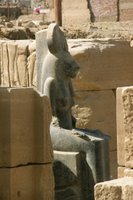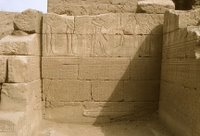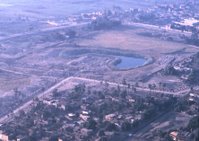Brooklyn Museum: Dig Diary

The Mut Expedition: An Introduction
 The goddess Mut was consort of Amun, one of Egypt's major gods, and mother of the moon god Khonsu and was one of the most important ancient Egyptian deities for over 2,000 years.
The goddess Mut was consort of Amun, one of Egypt's major gods, and mother of the moon god Khonsu and was one of the most important ancient Egyptian deities for over 2,000 years.

Mut was one of a group of goddesses known as the "Eye of Re" who had both a human and feline form. In her human form, Mut was protector of the Egyptian kingship and generally beneficent. As lioness-headed Sakhmet ("The Powerful One"), however, she controlled forces of pestilence and destruction that could defend Egypt but could be unleashed on Egypt if the goddess were not kept contented. Pacifying Sakhmet was one of the major goals of the priests in the Mut Precinct from at least the New Kingdom onward. Temple inscriptions tell that there was continual singing, dancing and feasting in the precinct -- all aimed at keeping Mut/Sakhmet happy and entertained.
Pacifying Sakhmet was one of the major goals of the priests in the Mut Precinct from at least the New Kingdom onward. Temple inscriptions tell that there was continual singing, dancing and feasting in the precinct -- all aimed at keeping Mut/Sakhmet happy and entertained.
 Since 1976, the Brooklyn Museum has been carrying out archaeological work at the Mut Precinct. The Museum's team, which has shared the site with an expedition from Johns Hopkins University since 2001, continues to explore how the Mut Precinct grew and what its inscriptions reveal about ancient Egyptian religion and life. Both expeditions are also devoted to the conservation and restoration of the site's monuments. The work of the Mut Expeditions is conducted under the auspices of the American Research Center in Egypt and is supervised by the Supreme Council of Antiquities, which authorizes and supervises all archaeological work in the country. Under the direction of its Secretary General, Dr. Zahi Hawass, the Supreme Council is responsible for the exploration, preservation, and restoration of Egypt's rich cultural heritage.The Mut Expedition's 21st season of fieldwork begins in January 2007. We will start posting regularly to this blog in mid-January and hope to continue through the end of the season in March.
Since 1976, the Brooklyn Museum has been carrying out archaeological work at the Mut Precinct. The Museum's team, which has shared the site with an expedition from Johns Hopkins University since 2001, continues to explore how the Mut Precinct grew and what its inscriptions reveal about ancient Egyptian religion and life. Both expeditions are also devoted to the conservation and restoration of the site's monuments. The work of the Mut Expeditions is conducted under the auspices of the American Research Center in Egypt and is supervised by the Supreme Council of Antiquities, which authorizes and supervises all archaeological work in the country. Under the direction of its Secretary General, Dr. Zahi Hawass, the Supreme Council is responsible for the exploration, preservation, and restoration of Egypt's rich cultural heritage.The Mut Expedition's 21st season of fieldwork begins in January 2007. We will start posting regularly to this blog in mid-January and hope to continue through the end of the season in March. In the meantime, for more information on the site and on past seasons of work there (including the 2005 and 2006 Dig Diaries), please visit the
Mut pages of the Brooklyn Museum website.
Richard Fazzini
Director, Mut Expedition
 The goddess Mut was consort of Amun, one of Egypt's major gods, and mother of the moon god Khonsu and was one of the most important ancient Egyptian deities for over 2,000 years.
The goddess Mut was consort of Amun, one of Egypt's major gods, and mother of the moon god Khonsu and was one of the most important ancient Egyptian deities for over 2,000 years. 

 Since 1976, the Brooklyn Museum has been carrying out archaeological work at the Mut Precinct. The Museum's team, which has shared the site with an expedition from Johns Hopkins University since 2001, continues to explore how the Mut Precinct grew and what its inscriptions reveal about ancient Egyptian religion and life. Both expeditions are also devoted to the conservation and restoration of the site's monuments.
Since 1976, the Brooklyn Museum has been carrying out archaeological work at the Mut Precinct. The Museum's team, which has shared the site with an expedition from Johns Hopkins University since 2001, continues to explore how the Mut Precinct grew and what its inscriptions reveal about ancient Egyptian religion and life. Both expeditions are also devoted to the conservation and restoration of the site's monuments. 



